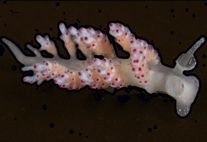Abstract
The nudibranch family Dotidae has been an extremely challenging group to study taxonomically due to their small body size, lack of distinct internal morphological differences and similar color patterns. This integrative systematic study of the Dotidae encompasses 29 individuals from the north Atlantic and Mediterranean, and 11 from the Indo-Pacific. Two mitochondrial genes, 16S, COI, and a nuclear gene, H3, were sequenced for 31 specimens and Bayesian and RAxML concatenated analyses were run. Dotidae is monophyletic and possesses strong geographic structure. Co-evolution between some of the north Atlantic taxa and their hydroid prey is apparent, thus supporting the hypothesis that speciation may be correlated with prey diversification. This study also supports the notion that the hydroid prey is a reliable indicator for distinguishing between cryptic species. Doto coronata Gmelin, the type species for the genus Doto, is re-described and a neotype, collected near Goes, Netherlands, is designated. From the molecular data, D. millbayana, D. dunnei, D. koenneckeri, D. maculata Lemche within the Doto coronata species complex, are confirmed to be distinct from D. coronata. Based on molecular data, specimens previously identified as D. coronata from South Africa are determined to represent a new species. It is described here and named Doto africoronata n. sp. Kabeiro n. gen. is introduced for the clade of elongate individuals from the Indo-Pacific, which diverges by 11.6% or greater in 16S from short-bodied Doto species. These elongate species are sister to all the short-bodied species and possess an enlarged pericardium, elongate cerata, a reproductive system with a pocketed prostate (penial gland), and an external tube-like digestive gland, which are absent in short-bodied Doto. Species of Kabeiro described here are: Kabeiro christianae n. sp., Kabeiro rubroreticulata n. sp., and Kabeiro phasmida n. sp. from the Philippines. The Indo-Pacific short-bodied species, Doto greenamyeri n. sp. from Papua New Guinea is also described.

